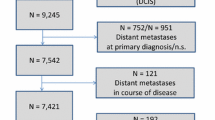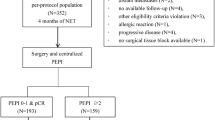Abstract
The predictive role of the degree of endocrine responsiveness to preoperative chemotherapy (PCT) is unclear. We reviewed pretreatment biopsies of 553 patients with locally advanced breast cancer who were treated with PCT. The incidence of pathological complete remission (pCR) and outcome were assessed with respect to the degree of estrogen (ER) and progesterone receptor (PgR) expression (ER and PgR absent, vs. ER or PgR 0–49%, vs. ER and PgR ≥50% of the cells positive). A statistically significant higher pCR rate was observed at the multivariate analysis for patients with ER and PgR absent tumors (17.7%) versus patients with tumors expressing high ER and PgR (0%) (OR 14.4 P < 0.001). Despite the higher incidence of pCR, a statistically significant worse disease-free survival (DFS), and overall survival (OS) was observed for patients with ER and PgR absent tumors versus patients with tumors expressing high ER and PgR (HR 6.4, 95% CI 3.5–11.6, for DFS; HR 3.6 95% CI 2.4–5.6 for OS). Response and outcome after PCT are correlated with the degree of expression of steroid hormone receptors. Studies on tailored preoperative therapies are needed.



Similar content being viewed by others
References
MacGrogan G, Mauriac L, Durand M et al (1996) Primary chemo-therapy in breast invasive carcinoma: predictive value of the immuno-histochemical detection of hormonal receptors, p53, c-erbB-2, MiB1, pS2 and GST pi. Br J Cancer 74:1458–1465
Fisher ER, Wang J, Bryant J et al (2002) Pathobiology of preoperative chemotherapy findings from the National Surgical Adjuvant Breast and Bowel Project (NSABP) protocol B-18. Cancer 95:681–695. doi:10.1002/cncr.10741
Faneyte IF, Schrama JG, Peterse JL et al (2003) Breast cancer response to neoadjuvant chemotherapy: predictive markers and relation with outcome. Br J Cancer 88:406–412. doi:10.1038/sj.bjc.6600749
Bear HD, Anderson S, Brown A et al (2003) The effect on tumor response of adding sequential preoperative docetaxel to preoperative doxorubicin and cyclophosphamide: preliminary results from National Surgical Adjuvant Breast and Bowel Project Protocol B-27. J Clin Oncol 21:4165–4174. doi:10.1200/JCO.2003.12.005
Ring AE, Smith IE, Ashley S (2004) Oestrogen receptor status, pathological complete response and prognosis in patients receiving neoadjuvant chemotherapy for early breast cancer. Br J Cancer 91:1–6. doi:10.1038/sj.bjc.6602235
Guarneri V, Broglio K, Kau SW et al (2006) Prognostic value of pathologic complete response after primary chemotherapy in relation to hormone receptor status and other factors. J Clin Oncol 24:1037–1044. doi:10.1200/JCO.2005.02.6914
Colleoni M, Viale G, Zahrieh D et al (2004) Chemotherapy is more effective in patients with breast cancer not expressing steroid hormone receptors: a study of preoperative treatment. Clin Cancer Res 10:6622–6628. doi:10.1158/1078-0432.CCR-04-0380
Hennessy BT, Hortobagy GN, Rouzier RN et al (2005) Outcome after pathologic complete eradication of cytologically proven breast cancer axillary node metastases following primary chemotherapy. J Clin Oncol 23:9304–9311. doi:10.1200/JCO.2005.02.5023
Goldhirsch A, Wood WC, Gelber RD (2007) Progress and promise: highlights of the international expert consensus on the primary therapy of early breast cancer 2007. Ann Oncol 18:1133–1144. doi:10.1093/annonc/mdm271
McShane LM, Altman DG, Sauerbrei W et al (2006) Reporting recommendations for tumor marker prognostic studies (REMARK). Breast Cancer Res Treat 100:229–235. doi:10.1007/s10549-006-9242-8
Kuerer HM, Newman LA, Smith TM et al (1999) Clinical course of breast cancer patients with complete pathologic primary tumor and axillary lymph node response to doxorubicin-based neoadjuvant chemotherapy. J Clin Oncol 17:460–469
Fechner RE (1975) Histologic variants of infiltrating lobular carcinoma of the breast. Hum Pathol 6:373–378. doi:10.1016/S0046-8177(75)80099-2
Colleoni M, Bonetti M, Coates AS et al (2000) Early start of adjuvant chemotherapy may improve treatment outcome for premenopausal breast cancer patients with tumors not expressing estrogen receptors. Int Breast Cancer Study Group J Clin Oncol 18:584–590
Albain K, Barlow W, O’Malley F et al (2004) Concurrent versus sequential chemohormonal therapy (cyclophosphamide, doxorubicin, 5-fluorouracil, tamoxifene) versus tamoxifen alone for postmenopausal, node-positive, estrogen and/or progesterone receptor-positive breast cancer: mature outcomes and new biologic correlates on phase III Intergroup trial 0100 (SWOG-8814). Breast Cancer Res Treat 88 (suppl 1) abs 37
Viale G, Regan MM, Maiorano E et al (2008) Chemoendocrine compared with endocrine adjuvant therapies for node-negative breast cancer: predictive value of centrally reviewed expression of estrogen and progesterone receptors-International Breast Cancer Study Group. J Clin Oncol 26:1404–1410. doi:10.1200/JCO.2007.10.6393
Stendhal M, Ryden L, Nordenskjöld B, Jönsson PE, Landberg G, Jirström K (2006) High progesterone receptor expression correlates to the effect of adjuvant tamoxifene in premenopausal breast cancer patients. Clin Cancer Res 12:4614–4618. doi:10.1158/1078-0432.CCR-06-0248
Regan MM, Viale G, Mastropasqua MG et al (2006) Re-evaluating adjuvant breast cancer trials: assessing hormone receptor status by immunohistochemical versus extraction assays. J Nat Cancer Inst 98:1571–1581
Sørlie T, Perou CM, Tibshirani R et al (2001) Gene expression patterns of breast carcinomas distinguish tumor subclasses with clinical implications. Proc Natl Acad Sci USA 98:10869–10874. doi:10.1073/pnas.191367098
Kaufmann M, von Minckwitz G, Smith R et al (2003) International expert panel on the use of primary (preoperative) systemic treatment of operable breast cancer: review and recommendations. J Clin Oncol 21:2600–2608. doi:10.1200/JCO.2003.01.136
Kaufmann M, von Minckwitz G, Bear HD et al (2007) Recommendations from an international expert panel on the use of neoadjuvant (primary) systemic treatment of operable breast cancer: new perspectives 2006. Ann Oncol 18:1927–1934. doi:10.1093/annonc/mdm201
Cristofanilli M, Gonzalez-Angulo A, Sneige N et al (2005) Invasive lobular carcinomaclassic type: response to primary chemotherapy and surgical outcomes. J Clin Oncol 23:41–48. doi:10.1200/JCO.2005.03.111
Tubiana-Hulin M, Stevens D, Lasry S et al (2006) Response to neoadjuvant chemotherapy in lobular and ductal breast carcinomas: a retrospective study on 860 patients from one institution. Ann Oncol 17:1228–1233. doi:10.1093/annonc/mdl114
Wolff AC, Hammond ME, Schwartz JN et al (2007) American society of clinical oncology/college of American pathologists guideline recommendations for human epidermal growth factor receptor 2 testing in breast cancer. Arch Pathol Lab Med 131:18
Rouzier R, Perou CM, Symmans WF et al (2005) Breast cancer molecular subtypes respond differently to preoperative chemotherapy. Clin Cancer Res 11:5678–5685. doi:10.1158/1078-0432.CCR-04-2421
Sørlie T (2007) Molecular classification of breast tumors: toward improved diagnostics and treatments. Methods Mol Biol 360:91–114
Rodriguez-Pinilla SM, Sarrio D, Honrado E et al (2006) Prognostic significance of basal-like phenotype and fascin expression in node-negative invasive breast carcinomas. Clin Cancer Res 12:1533–1539. doi:10.1158/1078-0432.CCR-05-2281
Fan C, Oh DS, Wessels L et al (2006) Concordance among gene-expression-based predictors for breast cancer. N Engl J Med 355:560–569. doi:10.1056/NEJMoa052933
Sotiriou C, Neo SY, McShane LM et al (2003) Breast cancer classification and prognosis based on gene expression profiles from a population-based study. Proc Natl Acad Sci USA 100:10393–10398. doi:10.1073/pnas.1732912100
Dowsett M, Harper-Wynne C, Boeddinghaus I et al (2001) HER2 amplification impedes the antiproliferative effects of hormone therapy in estrogen receptor-positive primary breast cancer. Cancer Res 61:8452–8458
Huang HJ, Neven P, Drijkoningen M et al (2005) Association between tumour characteristics and HER2/neu by immunohistochemistry in 1362 women with primary operable breast cancer. J Clin Pathol 58:611–616. doi:10.1136/jcp.2004.022772
Arpino G, Weiss H, Lee A et al (2005) Estrogen receptor positive, progesterone receptor-negative breast cancer: correlation with growth factor receptor expression and tamoxifen resistance. J Natl Cancer Inst 97:1254–1261
Nicholson RI, Hutcheson IR, Knowlden JM et al (2004) Nonendocrine pathways and endocrine resistance: observations with antiestrogens and signal transduction inhibitors in combination. Clin Cancer Res 10:346S–354S. doi:10.1158/1078-0432.CCR-031206
Barrett-Lee PJ (2005) Growth factor signalling in clinical breast cancer and its impact on response to conventional therapies: a review of chemotherapy. Endocr Relat Cancer 12(Suppl 1):S125–S133
Konecny G, Pauletti G, Pegram M et al (2004) Quantitative association between HER2/neu and steroid hormone receptors in hormone receptor-positive primary breast cancer. J Natl Cancer Inst 95:142–153
Colleoni M, Rotmensz N, Martinelli G et al (2004) Lesson learned from high-dose chemotherapy for high-risk breast cancer (what you see is what you mean). Ann Oncol 15:355–356. doi:10.1093/annonc/mdh054
Colleoni M, Viale G, Zahrieh D et al (2008) Expression of ER, PgR, HER1, HER2, and response: a study of preoperative chemotherapy. Ann Oncol 19:465–472. doi:10.1093/annonc/mdm509
Carey LA, Dees C, Sawyer L et al (2007) The triple negative paradox: primary tumor chemosensitivity of breast cancer subtypes. Clin Cancer Res 13:2329–2334. doi:10.1158/1078-0432.CCR-06-1109
Liedtke C, Mazouni C, Hess KR et al (2008) Response to neoadjuvant therapy and long-term survival in patients with triple negative breast cancer. J Clin Oncol 26:1275–1281. doi:10.1200/JCO.2007.14.4147
Acknowledgments
We thank the patients, nurses and physicians at the European Institute of Oncology.
Author information
Authors and Affiliations
Corresponding author
Rights and permissions
About this article
Cite this article
Colleoni, M., Bagnardi, V., Rotmensz, N. et al. Increasing steroid hormone receptors expression defines breast cancer subtypes non responsive to preoperative chemotherapy. Breast Cancer Res Treat 116, 359–369 (2009). https://doi.org/10.1007/s10549-008-0223-y
Received:
Accepted:
Published:
Issue Date:
DOI: https://doi.org/10.1007/s10549-008-0223-y




